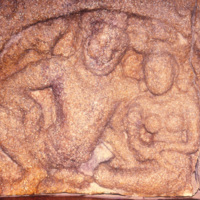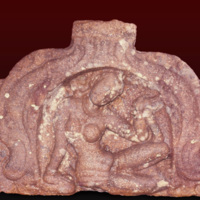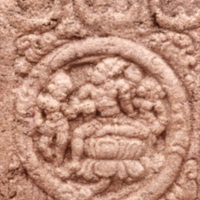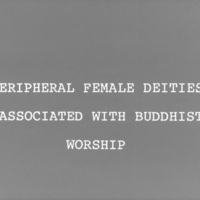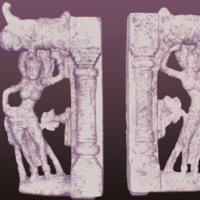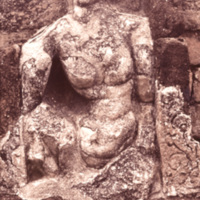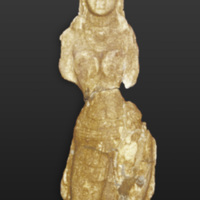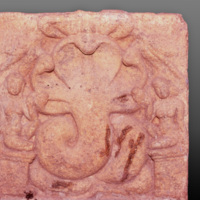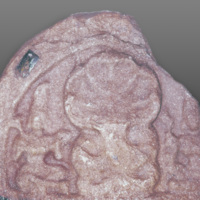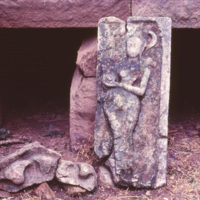Main Menu
AORC Libraries
Browse Items in Women in Sri Lankan Sculpture and Painting (166 total)
Consort of Bodhisattva
Description: This couple is carved within a stone niche, is in the museum at the Isurumuniya temple, Anuradhapura, Sri Lanka. The four-armed male figure is either a god or a Bodhisattva and the consort has on her lap a figure which has not been satisfactorily identified. Stylistically, this relief carving may be dated to the 6th to the 7th century A.D. period.
Contributor: Co-Author: Seneviratna, Harsha
Collection: Women in Sri Lankan Sculpture and Painting
Seated woman
Description: This single female carved in a niche, among the stone reliefs of the Isurumuniya Museum, Anuradhapura, Sri Lanka, can be dated between the 6th and 7th century A.D. on stylistic grounds.
Contributor: Co-Author: Seneviratna, Harsha
Collection: Women in Sri Lankan Sculpture and Painting
Divine consorts
Description: The two females in the company of an unidentified male god carved on one of the pillars at the Atadage temple, Polonnaruva, Sri Lanka may also fit into the category of divine consorts (ca. 11th-12th century A.D.).
Contributor: Co-Author: Seneviratna, Harsha
Collection: Women in Sri Lankan Sculpture and Painting
Peripheral Female Goddesses associated with Buddhist worship
Description: This text explains the functional roles that many peripheral gods and goddesses held in the Buddhist system of worship. Many peripheral gods and goddesses held positions of veneration or occupied certain functional roles within Buddhism. This phenomenon is noticed in the earliest Buddhist sculpture in India, at Bharhut, Sanchi and later at Amaravati. Supernatural beings provided models for Sri Lankan sculptors and they adorn these temples in both a protective and a devotional capacity.
Contributor: Co-Author: Seneviratna, Harsha
Collection: Women in Sri Lankan Sculpture and Painting
Divine maidens (apsaras) as guardian goddesses
Description: Discovered near the so-called Buddhist railing site in 1987 and housed in the site museum of the Jetavanarama Cultural Triangle Project at Anuradhapura, Sri Lanka, is this miniature gateway. It is in the style of the Amaravati School of Art in India, and may belong to about the 3rd century A.D. The two apsaras or divine maidens, leaning against two flowering trees, are cast in the role of guardian goddesses.
Contributor: Co-Author: Seneviratna, Harsha
Collection: Women in Sri Lankan Sculpture and Painting
Tags: AISLS, Guardian Goddesses, ICES, PDWESLSP
Terra-cotta guardian goddess
Description: Perhaps it is a protective role which is played by the gods and goddesses placed in niches in the superstructure of the Vahalakadas (gateways) of the Kantaka Cetiya at Mihintale, Sri Lanka. This goddess made of terra-cotta and covered with lime plaster occupies a side niche, the central position being reserved for the male god. Stylistically this sculpture may be attributed to the early Anuradhapura period (2nd century B.C.E.-1st century A.D.).
Contributor: Co-Author: Seneviratna, Harsha
Collection: Women in Sri Lankan Sculpture and Painting
Tags: AISLS, Guardian Goddesses, ICES, PDWESLSP
Limestone guardian goddess
Description: Excavated in 1982 this figure was found immediately outside the southern Vahalkada (gateway) of the Jetavanarama stupa is this fragmentary yet massive limestone figure of a goddess. The image probably belongs to the 3rd century A.D. The lotus head-dress suggests that it is a deity, perhaps a guardian goddess. It is presently housed in the site Museum of the Jetavanarama Cultural Triangle Project at Anuradhapura, Sri Lanka.
Contributor: Co-Author: Seneviratna, Harsha
Collection: Women in Sri Lankan Sculpture and Painting
Tags: AISLS, Guardian Goddesses, ICES, PDWESLSP
Cobra-guardians
Description: Nagas (cobras) and naginis (female cobras) as guardians: Nagas (cobras) are a clearly identifiable set of guardians of mostly Buddhist establishments and sometimes of secular structures such as tanks. This stone relief of a naga (cobra) with his two female companions on either side is said to be from Polonnaruva, Sri Lanka. It is now at the Colombo National Museum. Scholars have suggested a date in the early Polonnaruva period (ca. 10th-11th century A.D.).
Contributor: Co-Author: Seneviratna, Harsha
Collection: Women in Sri Lankan Sculpture and Painting
Six hooded cobra-guardian with consorts sporting a single hood
Description: A sculpture of a naga (cobra) of unknown date, at the Colombo National Museum, is this lime stone relief, flanked by two naginis (female cobras) with single hoods. The naginis are supportive of the central cobra.
Contributor: Co-Author: Seneviratna, Harsha
Collection: Women in Sri Lankan Sculpture and Painting
Female cobra-guardian
Description: This nagini (female cobra) relief with a single cobra hood on the side of her head lies near an old sluice at Eruvava in the Anuradhapura district, Sri Lanka. A few pieces of the central male cobra lie scattered in the area and the second female companion is missing. The sculpture is in a very wasted condition, but it is clear that she flanked the naga (cobra) on his left. The sculpture may be dated to the middle Anuradhapura period (ca. 6th-7th century A.D.) according to archaeologists.
Contributor: Co-Author: Seneviratna, Harsha
Collection: Women in Sri Lankan Sculpture and Painting



